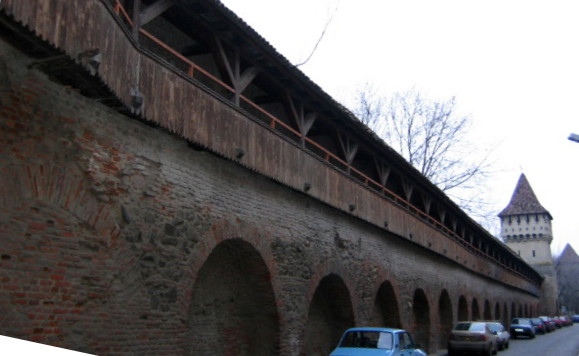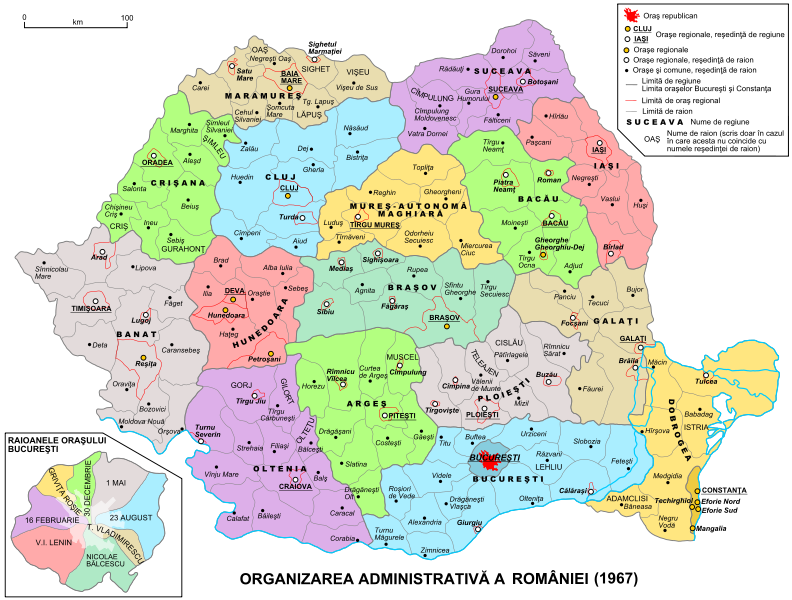|
Argeș Region
Regiunea Argeș (Argeș Region) was one of the newly established (in 1950) administrative Regions of the RPR, divisions of the Communist Romania, People's Republic of Romania, copied after the Soviet style of territorial organisation. It existed until 1952, when its territory merged with Vâlcea Region to form Pitești Region. After the 1956 reorganisation, Pitești Region changed its name back to Argeș. History The capital of the region was Pitești, and its territory comprised an area similar to the nowadays Argeș County, before the 1956 reorganisation. After the reorganisation it also comprised some of the area of the current Vâlcea County, Vâlcea and Argeș County, Argeș counties. Neighbors Argeș Region had as neighbors: *1950–1952: East: Prahova Region and București Region; South: Teleorman Region and Dolj Region; West: Vâlcea Region; North: Sibiu Region and Stalin Region. *1956–1968: East: Ploiești Region; South: București Region; West: Oltenia Region; North: ... [...More Info...] [...Related Items...] OR: [Wikipedia] [Google] [Baidu] |
Regions Of The RPR
The regions represented the result of a Soviet Union, Soviet-inspired experiment regarding the administrative and territorial organisation of the Romanian People's Republic (later Socialist Republic of Romania) between 1950 and 1968. See also: Administrative divisions of the People's Republic of Romania. Regions of 1950 *Regiunea Arad (Ar.) *Regiunea Argeș (Ptș.) *Regiunea Bacău (Bc.) *Regiunea Baia Mare (B.Mr.) *Regiunea Bârlad (Bd.) *Regiunea Bihor (Ord.) *Regiunea Botoșani (Bt.) *Regiunea București (R.B.) *Regiunea Buzău (Bz.) *Regiunea Cluj (Clj.) *Regiunea Constanța (Cța.) *Regiunea Dolj (Cv.) *Regiunea Galați (Gl.) *Regiunea Gorj (Tg.J.) *Regiunea Hunedoara (Dv.) *Regiunea Ialomița (Cl.) *Regiunea Iași (Iș.) *Regiunea Mureș (Tg.M.) *Regiunea Ploiești, Regiunea Prahova (Pl.) *Regiunea Putna (Fș.) *Regiunea Rodna (Btr.) *Regiunea Satu Mare (St.M.) *Regiunea Severin (Lgș.) *Regiunea Sibiu (Sb.) *Regiunea Stalin (O.S.) *Regiunea Suceava (Sv.) *Regiunea Teleorma ... [...More Info...] [...Related Items...] OR: [Wikipedia] [Google] [Baidu] |
Communist Romania
The Socialist Republic of Romania (, RSR) was a Marxism–Leninism, Marxist–Leninist One-party state, one-party socialist state that existed officially in Romania from 1947 to 1989 (see Revolutions of 1989). From 1947 to 1965, the state was known as the Romanian People's Republic (, RPR). The country was an Eastern Bloc state and a member of the Warsaw Pact with a dominant role for the Romanian Communist Party enshrined in :Template:RomanianConstitutions, its constitutions. Geographically, RSR was bordered by the Black Sea to the east, the Soviet Union (via the Ukrainian Soviet Socialist Republic, Ukrainian and Moldavian Soviet Socialist Republic, Moldavian SSRs) to the north and east, Hungarian People's Republic, Hungary and Socialist Federal Republic of Yugoslavia, Yugoslavia (via Socialist Republic of Serbia, SR Serbia) to the west, and People's Republic of Bulgaria, Bulgaria to the south. As World War II ended, Kingdom of Romania, Romania, a former Axis powers, Axis membe ... [...More Info...] [...Related Items...] OR: [Wikipedia] [Google] [Baidu] |
Pitești
Pitești () is a city in Romania, located on the river Argeș (river), Argeș. The capital and largest city of Argeș County, it is an important commercial and industrial center, as well as the home of two universities. Pitești is situated in the historical region of Muntenia. It lies on the A1 freeway (Romania), A1 freeway connecting the city directly to the national capital Bucharest, being an important railway junction, with a classification yard in nearby Bălilești. The city houses the Arpechim Refinery, Arpechim oil refinery, and is a marketing center for the Automotive industry in Romania, automotive industry, in particular, Automobile Dacia. Inhabited since Prehistory of the Balkans, prehistoric times but first mentioned in the 14th century, it developed as a trading town in northern Wallachia, serving as an informal residence for various Rulers of Wallachia, Wallachian Princes until the 18th century. From the 19th century and until the interwar period, it was an importa ... [...More Info...] [...Related Items...] OR: [Wikipedia] [Google] [Baidu] |
Argeș County
Argeș County () is a county (''județ'') of Romania, in Muntenia, with the county seat at Pitești. Demographics At the 2021 Romanian census, 2021 census, the county had a population of 569,932 and the population density was . At the 2011 Romanian census, 2011 census, it had a population of 612,431 and the population density was . * Romanians – 97% * Romani people in Romania, Roma (Gypsies) and Minorities of Romania, other ethnic groups – 3% Geography This county has a total area of . The landforms can be split into 3 distinctive parts. In the north side there are the mountains, from the Southern Carpathians group – the Făgăraș Mountains with Moldoveanu Peak (2,544 m), Negoiu Peak (2,535 m) and Vânătoarea lui Buteanu peak (2,508 m) towering the region, and in the North-East part the Leaotă Mountains. Between them there is a pass towards Brașov, the Rucăr–Bran Pass. The heights decrease, and in the center there are the sub-carpathian hills, with heights aro ... [...More Info...] [...Related Items...] OR: [Wikipedia] [Google] [Baidu] |
Vâlcea County
Vâlcea County (also spelt ''Vîlcea''; ) is a county (județ) that lies in south-central Romania. Located in the Historical regions of Romania, historical regions of Oltenia and Muntenia (which are separated by the Olt (river), Olt River), it is also part of the wider Wallachia region. Its capital city is Râmnicu Vâlcea. Demographics In 2011, it had a population of 355,320 and the population density was 61.63/km2. * Romanians - over 98% * Romani people in Romania, Roma, Minorities of Romania, others - 2% Geography This county has a total area of . The North side of the county is occupied by the mountains from the Southern Carpathians group: the Făgăraș Mountains in the east with heights over , and the Lotru Mountains in the west with heights over . They are separated by the Olt (river), Olt River valley — the most accessible passage between Transylvania and Muntenia. Along the Olt River valley there are smaller groups of mountains, the most spectacular being ... [...More Info...] [...Related Items...] OR: [Wikipedia] [Google] [Baidu] |
Prahova Region
Prahova may refer to: * Prahova (river), Romania * Prahova Valley, Romania * Prahova County Prahova County () is a county (județ) of Romania, in the Historical regions of Romania, historical region Muntenia, with the capital city at Ploiești. Demographics In 2011, it had a population of 762,886 and the population density was 161/k ..., named after the river Prahova, Romania ** Prahova Ploieşti, a football club based in Ploieşti, Romania ** Stadionul Prahova, a football-only stadium in Ploieşti, Romania See also * Prahovo, a village in the municipality of Negotin, Serbia {{disambiguation, geo ... [...More Info...] [...Related Items...] OR: [Wikipedia] [Google] [Baidu] |
București Region
Regiunea București (București/Bucharest region) was one of the newly established (in 1950) administrative divisions of the People's Republic of Romania, copied after the Soviet style of territorial organization. History The capital of the region was Bucharest, and at first, its territory comprised an area similar to the nowadays Ilfov and Giurgiu counties. In 1952 it assimilated the dissolved Ialomița Region (without raions Fetești, to Constanța Region, and Urziceni, to Ploiești Region; both taken in 1960) and Teleorman regions, reaching an area slightly smaller than nowadays Ialomița, Călărași, Ilfov, Giurgiu, and Teleorman counties. Neighbors București region had as neighbors: *1950–1952: East: Ialomița Region; South: People's Republic of Bulgaria; West: Teleorman Region; North: Argeș Region and Prahova Region. *1952–1960: East: Constanța Region; South: People's Republic of Bulgaria; West: Craiova Region; North: Pitești Region, Ploiești R ... [...More Info...] [...Related Items...] OR: [Wikipedia] [Google] [Baidu] |
Teleorman Region
Teleorman may refer to: * Teleorman County, a county of Romania * Teleorman (river), a river in southern Romania * The ''Teleorman'', a Romanian navy longboat lost in the Sinking of the Teleorman See also * Diocese of Alexandria and Teleorman * Teleormanu, a village in Mârzănești, Romania {{disambiguation, geo ... [...More Info...] [...Related Items...] OR: [Wikipedia] [Google] [Baidu] |
Dolj Region
''Regiunea'' Dolj (Dolj Region) was one of the newly established (in 1950) administrative divisions of the People's Republic of Romania, copied after the Soviet style of territorial organisation. History The capital of the region was Craiova, and its territory comprised what is today Dolj County. In 1952 it merged with Gorj Region to form the Craiova Region. Neighbours Dolj Region had as neighbours: *East: Teleorman Region and Argeș Region. *South: People's Republic of Bulgaria. *West: People's Republic of Bulgaria and Socialist Federal Republic of Yugoslavia *North: Gorj Region and Vâlcea Region. Raions Dolj Region comprised the following raion A raion (also spelt rayon) is a type of administrative unit of several post-Soviet states. The term is used for both a type of subnational entity and a division of a city. The word is from the French (meaning 'honeycomb, department'), and is c ...s: Craiova, Cujmir, Plenița, Calfat, Băilești, Segarcea, Gura Jiului, Corabia, ... [...More Info...] [...Related Items...] OR: [Wikipedia] [Google] [Baidu] |
Sibiu Region
Sibiu ( , , , Hungarian: ''Nagyszeben'', , Transylvanian Saxon: ''Härmeschtat'' or ''Hermestatt'') is a city in central Romania, situated in the historical region of Transylvania. Located some north-west of Bucharest, the city straddles the Cibin River, a tributary of the Olt River. Now the seat of Sibiu County, between 1692 and 1791 and 1849–65 Sibiu was the capital of the Principality of Transylvania. Until 1876, the Hecht hause in Sibiu served as the seat of the Transylvanian Saxon University. Nicknamed ''The Town with Eyes'' for the eyebrow dormers on many old buildings, the town is a popular tourist destination. It is known for its culture, history, cuisine, and architecture. In 2004, its historical center was added to the tentative list of UNESCO World Heritage Sites. Sibiu was subsequently designated the European Capital of Culture in 2007, along with Luxembourg City. One year later, it was ranked "Europe's 8th-most idyllic place to live" by ''Forbes''. Sibiu ... [...More Info...] [...Related Items...] OR: [Wikipedia] [Google] [Baidu] |
Stalin Region
Regiunea Stalin (Stalin Region) was one of the administrative divisions of the People's Republic of Romania. It was established in 1950, in the Soviet style of territorial organization, and was named after Joseph Stalin. Its name was changed to Brașov Region in 1960, and it was disestablished in 1968. History In 1950, the capital of the region was Orașul Stalin (''Stalin City'', now Brașov) and its territory comprised an area similar to what are nowadays the eastern part of Brașov County, together with Covasna County and part of Harghita County. Initially, the Stalin Region comprised 6 raions: Ciuc, Odorhei, Racoș, Sfântu Gheorghe, Stalin, and Târgu Secuiesc. In 1952, the Ciuc, Odorhei, Sfântu Gheorghe, and Târgu Secuiesc raions were transferred to the newly established Magyar Autonomous Region, while the raions Sibiu, Făgăraș, Mediaș, Agnita, Sighișoara, and Târnăveni were included in the Stalin Region. In 1960, the region was renamed Brașov Region, while ... [...More Info...] [...Related Items...] OR: [Wikipedia] [Google] [Baidu] |



